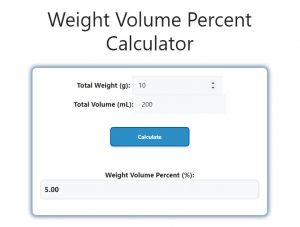About Weight Volume Percent Calculator (Formula)
The Weight Volume Percent Calculator is a helpful tool for calculating the concentration of a substance in a solution, expressed as a percentage. This is particularly useful in chemistry, medicine, food science, and industrial processes, where accurate measurements of concentration are crucial. The calculator simplifies the process of determining how much of a substance is present per unit of volume.
Formula
The formula to calculate weight/volume percent is:
WVP = (Weight / Volume) * 100
Where:
- WVP = Weight Volume Percent (the concentration in percentage)
- Weight = The weight of the substance (usually in grams)
- Volume = The volume of the solution (usually in milliliters or liters)
This formula calculates the concentration by dividing the weight of the substance by the total volume of the solution and multiplying the result by 100 to express it as a percentage.
How to Use
- Determine the weight of the substance: Measure the weight of the solute (the substance you are dissolving) in grams.
- Measure the total volume of the solution: Identify the volume of the solvent (the liquid in which the solute is dissolved) in milliliters or liters.
- Input the values: Enter the weight and volume into the calculator.
- Click Calculate: The calculator will provide the weight/volume percent concentration of the substance in the solution.
Example
Let’s say you have 10 grams of salt dissolved in 200 milliliters of water. Using the formula:
WVP = (10 / 200) * 100 = 0.05 * 100 = 5%
The solution has a 5% weight/volume concentration of salt.

FAQs
- What is weight/volume percent?
Weight/volume percent (WVP) is a measure of concentration, representing the amount of a substance (in grams) per 100 milliliters of solution. - Why is weight/volume percent important?
It is essential for preparing solutions in chemistry, medicine, food production, and industrial applications where accurate concentrations are required. - What units are used in this calculation?
The weight is typically measured in grams, and the volume in milliliters or liters. - Can the weight/volume percent exceed 100%?
No, the weight/volume percent typically ranges between 0% and 100%, indicating the proportion of the substance in the solution. - Is weight/volume percent the same as mass/volume percent?
Yes, weight/volume percent and mass/volume percent are terms used interchangeably, both referring to the concentration of a substance in a solution. - How does this differ from molarity?
Weight/volume percent is based on the mass of the substance, while molarity is based on the number of moles of solute in a given volume of solution. - Can this formula be used for gases?
No, this formula is specific to solids or liquids dissolved in a liquid. Gases require different methods to measure concentration. - How is weight/volume percent used in medicine?
In medicine, weight/volume percent is commonly used to prepare solutions like saline, where the concentration of salt in water needs to be precise. - What if I have the volume in liters?
If your volume is in liters, convert it to milliliters by multiplying by 1,000 before applying the formula. - Does temperature affect weight/volume percent?
Temperature can affect the volume of liquids, but the weight/volume percent remains the same as long as the weight and volume are measured accurately at the same temperature. - What is the difference between weight/volume and volume/volume percent?
Weight/volume percent measures the concentration of a solid or liquid in a liquid, while volume/volume percent is used when both components are liquids. - Can I use this formula for preparing dilutions?
Yes, this formula is useful when preparing solutions of specific concentrations by controlling the weight of the solute and the volume of the solvent. - What does a 10% weight/volume solution mean?
A 10% weight/volume solution means there are 10 grams of solute in every 100 milliliters of solution. - Can this calculator be used for suspensions?
Yes, the calculator works for both solutions and suspensions, as long as the weight of the substance and volume are known. - What if the solute doesn’t dissolve completely?
If the solute doesn’t dissolve completely, the concentration may vary, and it could affect the accuracy of the calculation. - Is there a limit to how concentrated a solution can be?
Yes, solutions have a solubility limit beyond which the solute cannot dissolve in the solvent, depending on the substance and solvent. - What if I have multiple solutes?
For multiple solutes, calculate the weight/volume percent for each solute separately. - Can this formula be used in food science?
Yes, the weight/volume percent is commonly used in food science to determine concentrations in products like sauces or beverages. - How is weight/volume percent useful in cleaning solutions?
Weight/volume percent helps ensure cleaning solutions have the correct concentration of active ingredients for effective use. - Does the solvent’s density affect the calculation?
The density of the solvent does not directly affect the weight/volume percent, as the formula only considers the total volume of the solution.
Conclusion
The Weight Volume Percent Calculator is a practical tool for calculating the concentration of a substance in a solution. It is widely used in chemistry, medicine, food science, and various industrial processes to ensure accurate formulation of solutions. By using this calculator, you can easily determine the percentage of a substance in any given volume of solvent, making it a valuable resource for precision in different applications.
